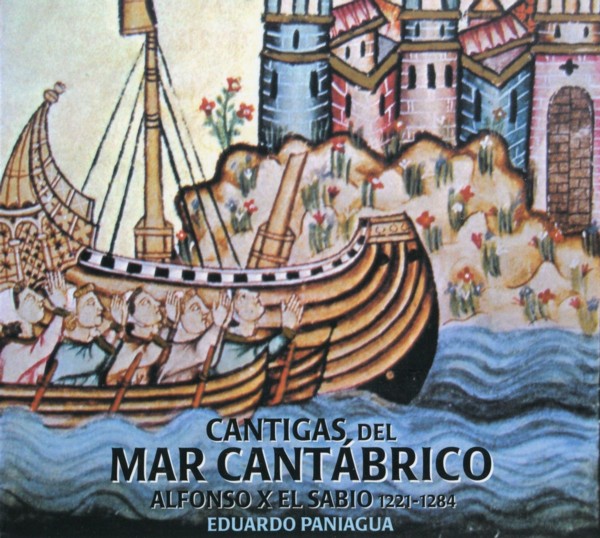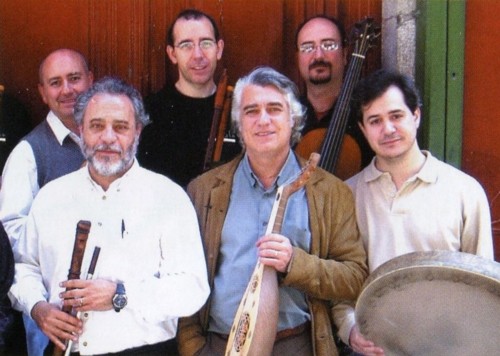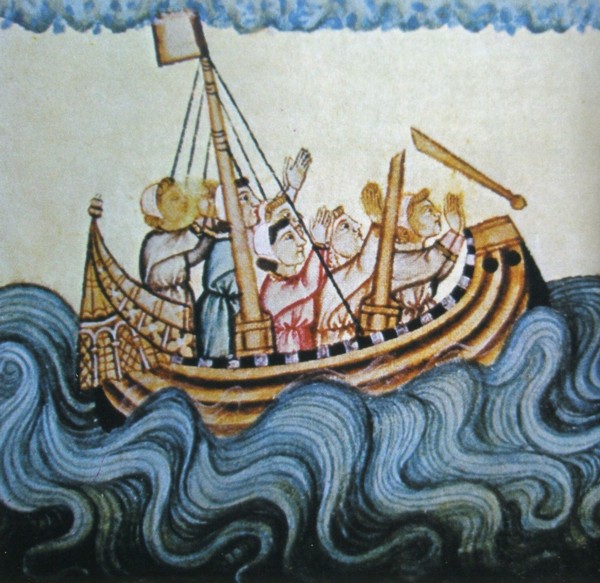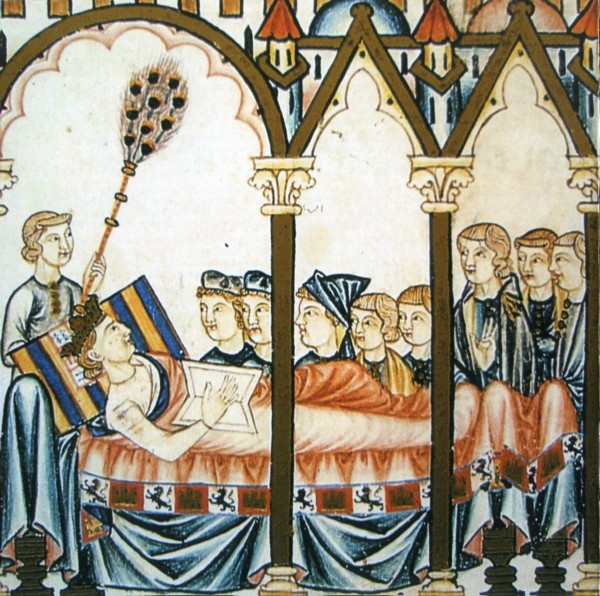Alfonso X el Sabio, 1221-1284. Cantigas del Mar Cantábrico
Eduardo Paniagua · Música Antigua

medieval.org
Pneuma «Colección Cantigas» PN-1170
2009
DON ALFONSO DE CASTILLA ENFERMO EN VITORIA
1. Muito faz grand 'erro [7:11]
CSM 209
canto · vihuela, axabeba, flauta y campanil
LOS MARINEROS DE COLLIURE
2. Nas coitas devemos chamar [4:47]
CSM 112
canto y coro · viola, salterio, flautas, fhal, cántara
y agua palmeada
MIL AVE MARÍAS
3. Nulla enfermidade [7:17]
CSM 93
canto y coro · viola, salterio, flauta y campanil
LOS MARINEROS DE LAREDO
4. Sen muito ben que nos face [6:50]
CSM 248
canto y coro · viola, vihuela, órgano de mano,
chalumeau, flauta, darbuga, daf y gong
DOS MONJES RENEGADOS
5. O nome da Virgen santa [5:27]
CSM 254
canto y coro · violas, flauta, fhal, salterio, darbuga,
platillos, crótalos y cascabeles
6. EL FRAILE DE BURGOS
[Poi-lo pecador punnar] [5:34]
CSM 274
vihuela, órgano de mano, cálamo, salterio, darbuga y
cántara
CURACIÓN EN CUDEYO DE SANTANDER
7. Muit' é ben-aventurado [7:51]
CSM 263
canto y coro · viola, vihuela, salterio, órgano de
mano, axabeba, flauta, darbuga y panderos
LA TABERNA DE LAREDO
8. Gran dereit' é que mal venna [7:01]
CSM 244
canto · violas, chalumeau, vihuela, pandero y campanil
LA MANCEBA DE CAHORS
9. A Madre do que o demo [8:32]
CSM 343
canto y coro, violas, salterio, flautas, darbuga y cántara

MÚSICA ANTIGUA
Eduardo Paniagua
CESAR CARAZO: canto y coro, viola
LUIS ANTONIO MUÑOZ: canto y coro, viola
JAVIER COBLE: órgano de mano y campanil
FELIPE SÁNCHEZ: vihuela de péñola
JAIME MUÑOZ: axabeba, cálamo y chalumeau
EDUARDO PANIAGUA: salterio, fhal, flautas, darbuga, cántara,
agua palmeada, platillos, crótalos, cascabeles, campanil y gong
Invitado:
DAVID MAYORAL: darbugas, panderos y daf (274, 248 y 263)
Grabado en el 2009 en Axis, Madrid por Hugo Westerdahl
Producción artística: Eduardo Paniagua.
Premio mejor intérprete Música Clásica 2009 de la
Academia de la Música de España
Diseño gráfico: Pneuma
Portada: Miniatura Cantiga 112, Los marineros de Collioure
Bandeja interior: Cantiga 209, Don Alfonso de Castilla duerme en Vitoria
Traducción poemas: José Filgueira y José Snow
English translation: Lesley Ann Shuckburgh
Producción: EDUARDO PANIAGUA • 2009 PNEUMA
Depósito Legal: M-14143-2009
Comunidad de Madrid • La Suma de Todos
Caja Madrid • Fundación
GRABACIÓN INTEGRAL. CANTIGAS ALFONSO X EL SABIO
BIEN CULTURAL. PATRIMONIO INMATERIAL
Agradecimiento: D.G. Patrimonio Histórico y
D.G. Promoción Cultural de la Comunidad de Madrid
English liner notes
CANTIGAS DEL MAR CANTÁBRICO
El mar Cantábrico es un mar del océano Atlántico
que baña la costa norte de España y la costa suroeste de
Francia. Se extiende desde la provincia de La Coruña, hasta
Brest en el Finisterre de Bretaña. En su parte más
oriental, junto a las costas del País Vasco recibe el nombre de
golfo de Vizcaya y golfo de Gascuña. Los frecuentes vientos del
noroeste y la amplitud de sus mareas hacen de él un mar bravo
con frecuentes resacas y olas de gran altura. Fue bautizado por los
romanos en el siglo I a. C. como Cantabricus Oceanus
(Océano de los cántabros) y en citas clásicas
más antiguas como Gallicus Oceanus. Esta
selección de cantigas de Santa María comprende milagros
locales en relación con este mar. En Francia tiene su influencia
el santuario de Rocamadour y en España la iglesia de Laredo en
Cantabria y otras del país vasco. Son milagros de
clérigos y de ambiente marinero, como la cantiga 244 en la que
un impío prefiere ir a la taberna antes que a la iglesia para
celebrar la captura de una ballena, o la cantiga 248 en la que dos
marineros que pelean a muerte con cuchillos en la iglesia, o la cantiga
112 en la que una tempestad en el Cantábrico hace abandonar el
barco que transportaba trigo de Colliure. Hemos incluido en esta
selección la cantiga 209, biográfica del rey Sabio en
Vitoria, con la curación de su enfermedad al colocar sobre su
pecho el voluminoso códice de las Cantigas. Se constata el poder
curativo de Santa María y el valor del propio Cancionero que el
rey llevaba en sus viajes, y que escribía con ayuda de sus
poetas, músicos y dibujantes. La mayoría de estas
cantigas están conservadas con sus miniaturas en el
Códice de Florencia, el segundo volumen historiado con
imágenes perteneciente a la cámara regia Las cantigas 244
y 343 sólo están en el “Códice de los
músicos“, conservado en San Lorenzo de El Escorial. Su
traducción al castellano la ha realizado el profesor Joseph Snow
por encargo de esta edición.
1 - CSM 209. DON ALFONSO DE CASTILLA ENFERMO EN VlTORIA. “Muito
faz grand 'erro”
Narración autobiográfica en primera persona de la
enfermedad sufrida por el Rey Sabio en Vitoria entre el verano de 1276
y la primavera de 1277. El rey gravemente enfermo sólo se cura
cuando le ponen sobre su cuerpo el primer libro de las Cantigas de
Santa María. El códice entonces sólo
contenía 100 canciones y sería similar al actualmente
conservado Códice de Toledo. Esta cantiga muestra la fe del rey
en su obra lírica, al decir “no me place nada más
que loar a la Virgen” y “me ayuda en los malos momentos, me
quita el dolor y me hace otros muchos favores”.
2 - CSM 112. LOS MARINEROS DE COLLIURE. “Nas coitas devemos
chamar”
Los marineros de Colliure en los Pirineos, para salvarse durante una
tempestad abandonaron su barco, que estaba cargado de harina. Al ver la
nave llena de agua y revuelta con arena pidieron ayuda a la Virgen.
Cuando llegaron a puerto en los bateles descubrieron la nave y la
harina salvadas, y por ello comenzaron a alabar a Santa María.
En el refrán se invoca a la Virgen como “estrella del
mar” en referencia a la cantiga 100 “Santa María
estrella del día”.
3 - CSM 093. MIL AVE MARIAS. “Nulla enfermidade”
El hijo de un burgués, que era apuesto y letrado se entregaba al
vicio de la carne. Quiso Dios que le atormentara la lepra y por ello se
retiró del mundo a una ermita donde pasó tres años
rezando diariamente mil “Ave Marías” para pedir
perdón a la Virgen. La Virgen se apiadó de él y en
una aparición le ungió el cuerpo con su Santa Leche.
Mudó la piel y curó la lepra, y contaba a todos que le
había salvado la confianza en Santa María.
4 - CSM 248. LOS MARINEROS DE LAREDO. “Sen muito ben que nos
face”
Dos marineros se retaron a muerte con cuchillos en la iglesia de Santa
María de Laredo “que se halla sobre la mar”. La
Virgen hizo que delante de toda la gente quedaran inmóviles uno
frente a otro como estatuas. Paralizados y arrepentidos pidieron gracia
a Santa María, que escuchó su oración. Se
perdonaron mutuamente y recuperaron el movimiento. Todos los presentes
loaron de corazón a Santa María. Laredo era una plaza
fuerte amurallada y con un importante puerto. Sus naves tomaron parte
activa en la conquista de Sevilla a los andalusíes en 1248. Una
de ellas rompió la cadena que guardaba el río
Guadalquivir junto a la actual Torre del Oro.
5 - CSM 254. DOS MONJES RENEGADOS. “O nome da Virgen santa”
Localizada en Francia, la cantiga cuenta como dos monjes abandonaron su
monasterio hartos de penalidades y trabajos. Iban bromeando junto al
río cuando vieron una barca dirigida por unos demonios que
llevaban el alma de Hebrón, un alguacil de la zona. Exclamaron
los monjes “Santa María nos valga”, y a causa de esa
invocación los diablos no se llevaron el alma al infierno. Los
monjes asustados volvieron al monasterio y confesando su huída
consiguieron el perdón de Dios.
6 - CSM 274. EL FRAILE DE BURGOS. Instrumental
7 - CSM 263. CURACIÓN EN CUDEYO DE SANTANDER.
“Muit'é ben-aventurado”
Un hombre de Cudeyo, junto a Santander, que tenía todo el cuerpo
paralizado, no dejaba de llorar pidiendo la salud a Santa María.
Un día se le apareció y le dijo que si quería que
le curase su enfermedad, tendrían que llevarle a su iglesia, que
encargara una misa y que adorase la eucaristía. Así hizo
y se curó. Después lo fue contando hasta llegar a la mar,
mientras los presentes loaban a Santa María.
8 - CSM 244. LA TABERNA DE LAREDO. “Gran dereit' é que mal
venna”
Una ballena vino a morir al puerto de Laredo y la gente sorprendida
acabó rezando en la iglesia ante este hecho. Pero un marinero se
burlaba de la gente y se jactaba de preferir ir a celebrarlo en la
taberna. Después de beber vino se le hinchó el cuerpo de
tal modo que pidió a sus familiares que le llevaran a la
iglesia, donde después de una donación y una misa Santa
María le curó.
9 - CSM 343. LA MANCEBA DE CAHORS. “A Madre do que o demo”
Una mujer francesa de Cahors tenía una hija hermosa que fue
poseída por el diablo. Este a través de la chica
decía sin pudor a la gente los pecados que había
cometido. La madre pidió ayuda al capellán de la iglesia,
pero el diablo le injurió y también le dijo
públicamente sus pecados. La madre avergonzada decidió
llevar a su hija al santuario de Rocamador, cerca de Gascuña, y
pidió ayuda a Santa María. La oración fue
escuchada y la Virgen hizo callar al diablo y sanar a la moza.
Eduardo Paniagua
CANTIGAS OF THE CANTABRIAN SEA
The Cantabrian Sea is in the Atlantic Ocean and laps the northern coast
of Spain and the south western coast of France. It stretches from the
province of La Coruña to Brest in Finisterre, Brittany. In the East, on
the Basque coast, it is known as the Bay of Biscay and the Bay of
Gascony.
North-westerly winds are common, and together with the
magnitude of the tides they make it a rough sea with frequent
undercurrents and very high waves. It was baptized by the Romans in the
1st Century B.C. as the Cantabricus Oceanus (Ocean of the Cantabri) and in older classical references it is referred to as Gallicus Oceanus.
This selection of Cantigas
of Holy Mary embraces the local miracles related to this sea. Reference
is made to the sanctuary of Rocamadour in France and to the church of
Laredo in Cantabria and churches in the Basque Country in Spain. The
songs are about miracles involving the clergy and take place in maritime
surroundings as in the case of Cantiga 244 in which an irreverent man prefers the tavern to the church to celebrate the capture of a whale, or Cantiga 248 in which two sailors fight to death with knives in the church, or Cantiga 112 in which a storm in the Cantabrian Sea forces the crew to abandon a ship that carried wheat from Colliure.
We
have included Cantiga 209 in this selection, which makes biographical
reference to the life of the Wise king in Vitoria, where his illness was
cured by putting the voluminous codex of the Cantigas on his chest.
Holy Mary's curative power was confirmed as well as the value of the
songbook itself which the king took with him on his travels. He in fact
was the author, with the help of his poets, musicians and illustrators.
Most
of these Cantigas, with their miniatures, are preserved in the Codex of
Florence, the second best known illustrated volume that belonged to the
royal chamber. Cantigas 244 and 343 are only in the
"Musicians'Codex", preserved in San Lorenzo de El Escorial in Spain.
This codex was translated into Castilian Spanish by Professor Joseph
Snow especially for this recording.
1. CSM 209. KING ALFONSO OF CASTILE FALLS ILL IN VITORIA. "Muito faz grand'erro"
This
autobiographical tale tells the story in the first person of the
illness suffered by the Wise King in Vitoria between the summer of 1276
and the spring of 1277. The king was seriously ill and was only cured
when the first book of the Cantigas of Holy Mary was placed on
his body. The codex then only contained 100 songs and would be similar
to the one that now survives, the Codex of Toledo. This Cantiga
demonstrates how the king's faith is revealed in his lyrical work, by
saying "nothing is more pleasing than worshipping the Virgin" and "She
helps me at bad times, she takes away the pain and does me many other
favours".
2. CSM 112. THE SAILORS FROM COLLIURE. "Nas coitas devemos chamar"
Sailors
from Colliure in the Pyrenees abandoned their ship loaded with flour to
save their lives during a tempest. When they saw the ship filling up
with water and being swallowed up by the sand they asked the Virgin for
help. On reaching port in the lifeboats they found the ship and the
flour safe and sound, so they began to praise Holy Mary. In the refrain
the Virgin is invoked as the "star of the sea" in reference to Cantiga 100 "Holy Mary Star of the Day".
3. CSM 93. ONE THOUSAND AVE MARIAS. "Nulla enfermidade"
The
good looking and learned son of a townsman was prone to give in to the
vice of the flesh. It was God's will that he should be tormented by
leprosy and so he retired from the world to a hermitage where he spent
three years praying one thousand "Ave Marias" a day to ask Holy Mary for
forgiveness. The Virgin took pity on him and in an apparition anointed
his body with Holy Milk. His skin flaked off and the illness was cured.
He then told everyone that faith in Holy Mary had saved him.
4. CSM 248. THE SAILORS FROM LAREDO. "Sen muito ben que nos face"
Two
sailors challenged each other to death at knife-point in the church of
Holy Mary of Laredo "which is located near the sea". The Virgin turned
them into statues face to face. Paralyzed and repentant they asked for
Holy Mary's forgiveness and She heard their prayer. They forgave each
other and regained control of their bodies. Everybody present praised
Holy Mary from the heart. Laredo was a walled stronghold with an
important port. Its ships took an active part 6 in the conquest of
Seville from the Andalusis in 1248. One of them broke the chain next to
the present day Golden Tower, which protected the entrance to the river
Guadalquivir.
5. CSM 254. TWO RENEGADE MONKS. "O nome da Virgen santa"
Located in France, this Cantiga
is about two monks who abandoned their monastery tired of the hardships
and work. They were messing about near the river when they saw devils
taking the soul of Hebron, a bailiff of the region, to hell in a boat.
The monks exclaimed "Holy Mary protect us", and because of this
invocation the devils did not take the soul to hell. The frightened
monks returned to the monastery and by confessing their escape managed
to obtain God's pardon.
6. CSM 274. THE FRIAR Of BURGOS. Instrumental
7. CSM 263. CURE IN CUDEYO DE SANTANDER. "Muit'é ben-aventurado"
A
man from Cudeyo near Santander, who was completely paralyzed, never
stopped crying asking Holy Mary for health. One day She appeared before
him and told him that if he wanted Her to cure his illness he would have
to be taken to the church, where he should order a mass and worship the
Eucharist. He did so and he was cured. Afterwards on his way to the
sea, he told everybody what had happened, and those present praised Holy
Mary.
8. CSM 244. THE TAVERN IN LAREDO. "Gran dereiré que mal venna"
A
whale came to die in Laredo harbour and the people were so surprised
that they ended up praying in the church. But a sailor made fun of the
people and showed off saying he preferred to celebrate what had happened
in the tavern. After drinking wine his body swelled so much that he
asked his family to take him to the church, where after a donation and a
mass Holy Mary cured him.
9. CSM 343. THE MAID FROM CAHORS. "A Madre do que o demo"
A
French woman from Cahors had a beautiful daughter who was possessed by
the devil. Abandoning all modesty he went about shouting out the sins he
had committed, through the little girl. The mother asked the chaplain
of the church for help, but the devil insulted him and also blurted out
his sins. The embarrassed mother decided to take her daughter to the
sanctuary of Rocamadour, near Gascony, where she asked Holy Mary for
help. Her prayer was heard and the Virgin silenced the devil and cured
the girl.
Eduardo Paniagua




